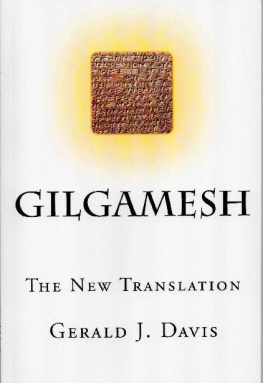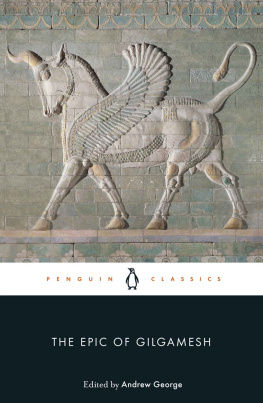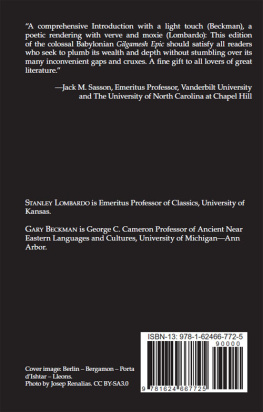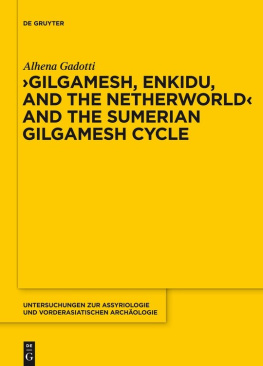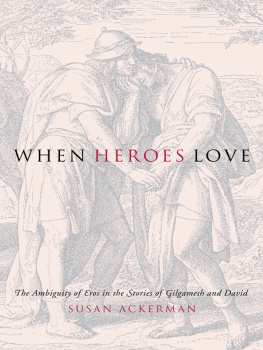Gilgamesh
The New Translation
Gerald J. Davis
Insignia Publishing
Translation Copyright 2014 by Gerald J. Davis
All rights reserved. No part of this book may be reproduced, stored in a retrieval system or transmitted in any form or by any means, graphic, electronic or mechanical, without the prior written permission of the publisher, except by a reviewer who may quote brief passages in a review to be printed online, in a newspaper, magazine or journal.
Insignia Publishing
Bridgeport, Connecticut
For Jacob and Teddy
Also by Gerald J. Davis
Beowulf, The New Translation
Don Quixote, The New Translation
Left No Forwarding Address
Jungle of Glass
A Murder Too Personal
Table of Contents
A Note on the Translation
By
Gerald J. Davis
The Epic of Gilgamesh is the oldest story that has come down to us through the ages of history. It predates the Bible , the Iliad and the Odyssey . The Epic of Gilgamesh relates the tale of the fifth king of the first dynasty of Uruk (in what is modern day Iraq) who reigned for one hundred and twenty-six years, according to the ancient Sumerian King List. Gilgamesh was first inscribed in cuneiform writing on clay tablets by an unknown author during the Sumerian era and has been described as one of the greatest works of literature in the recounting of mankinds unending quest for immortality. Gilgamesh the King is thought to have lived in the period from 2850 B.C. to 2700 B.C., and was later worshipped as a cult hero. The earliest Gilgamesh poems, related in oral form, are believed to have originated around 2200 B.C., and the first in written form around 2000 B.C.
Ancient Sumer was, in all probability, the first civilization in history, established during the fifth millennium B.C. It was the first society to have a written language, which began, according to the latest scholarship, around 3500 B.C. The Sumerians were a non-Semitic people whose likely origins were in northern Mesopotamia. Sumerian was a language with no known analogs; that is to say, it had no relationship to any known existing languages.
Akkadian gradually began to replace Sumerian as a spoken language during the second millennium B.C., but Sumerian continued to be used for religious, legal, ceremonial, scholarly and scientific purposes until about 1800 B.C. The Akkadians were a Semitic people from the West who conquered Sumer about 2300 B.C. Akkadian was the earliest Semitic language, related to Arabic and Hebrew, and the Akkadians, after their conquest of Sumer, adopted cuneiform, which was originally used to write Sumerian.
The clay tablets like those upon which the Epic of Gilgamesh were inscribed were in common use in the ancient Middle East. They were generally of a size (about 6 by 7) which could be held easily in one hand and were usually written on both sides. These tablets were inexpensive, easily transported and, when fired, were long-lasting. In the ancient society of Sumer, writing began as a form of record-keeping, and the earliest examples of inventories, accounting records, legal documents and correspondence appear in these clay tablets. The clay tablets, when wet and soft, were impressed with a reed stylus in order to inscribe the wedge-shaped cuneiform characters and symbols. In fact, the word cuneiform is derived from the Latin, cuneus , meaning wedge and forma , meaning shape.
The meaning and import of these clay tablets was unknown for thousands of years until, in the early nineteenth century, the cuneiform characters began to be deciphered by European scholars. But it was the visit during the 1830s by Major General Sir Henry Rawlinson (1810-1895), sometimes called the Father of Assyriology, a British East India Company Army officer, to Kermanshah in western Persia, which led to the first important breakthrough in the decipherment of these ancient languages. There, carved upon a stone cliff-side on Mount Behistun, is an inscription fifteen meters high by twenty-five meters wide, depicting events that occurred before and during the reign of Darius the Great from 522 B.C. to 486 B.C. This Behistun Inscription is a tri-lingual cuneiform monument written in Akkadian, Elamite and Old Persian. Thus, it is comparable to the Rosetta Stone in that it enabled scholars to decipher a previously undecipherable ancient script. (Unfortunately, this timeless monument suffered damage during World War II when Allied soldiers used it for target practice.) While engaging in combat during the First Afghan War between Britain and Afghanistan from 1839 to 1842, for which he was awarded the Companion of the Order of the Bath for valor in 1844, Rawlinson transcribed and deciphered the inscriptions on Mount Behistun. He presented his results to the Royal Asiatic Society in London and, for his efforts, Rawlinson was elected a Fellow of the Royal Society in 1850 as The Discoverer of the Key to the Ancient Persian, Babylonian and Assyrian Inscriptions in the Cuneiform Character.
At about the same time, in 1851, an English archaeologist named Sir Austen Henry Layard (1817-1894) unearthed the ruins of the ancient Library of Ashurbanipal in northern Mesopotamia (present-day Iraq). Ashurbanipal was the last major Assyrian king of the seventh century B.C., known as a successful military commander and a renowned scholar. The Library of Ashurbanipal was found to contain tens of thousands of clay tablets and fragments, among them the Epic of Gilgamesh . Most of these tablets and fragments were subsequently transported to England and can be viewed as part of the collection of Assyrian antiquities in the British Museum, of which Layard was appointed a Trustee in 1866.
But the true hero of the Epic of Gilgamesh is an Englishman named George Smith (1840-1876). Poor and of humble background, Smith left school at the age of fourteen and became the apprentice to a printer. He married young and eventually had six children. However, bored by his work and entranced by ancient history, he began to frequent that collection of Assyrian antiquities at the British Museum in London, not far from his place of employment. Smith spent so much time poring over the cuneiform tablets that he became adept at reading the inscriptions, and he was called to the attention of Sir Henry Rawlinson, who convinced the British Museum to hire Smith at a minimal salary to work on the tablets in its collection and study the cuneiform texts. Smiths work proved so important to the British Museum that he was promoted to the position of Senior Assistant in the Department of Assyriology in 1870. During the course of Smiths study of the tablets, he happened to encounter a fragment of Layards Gilgamesh and its relating of the story of the Great Deluge, together with a description of a Noah-like character, the manner of construction of the ark, the embarkation of the animals, the birds sent forth to seek dry land and the ark coming to rest upon a mountain. (This segment is from Tablet XI of the Epic.) When Smith deciphered this, in 1872, he said, I am the first man to read that after more than two thousand years of oblivion. In that year, Smith achieved worldwide renown by his translation and publication of this account of the Great Deluge, and, on December 3, 1872, he presented his paper before the Society of Biblical Archaeology, with Prime Minister William Gladstone in attendance. Smiths discovery was hailed as one of the most important in the history of archaeology and created an overnight sensation in Victorian England, and the news of it was swiftly reported in publications on both sides of the Atlantic. Biblical scholars were stunned to learn of an account of the Great Deluge that may have predated the Bible by thousands of years and it upended centuries of scriptural scholarship. Some experts even began to promulgate the theory that the Israelites may have appropriated the story of the Great Deluge for their Hebrew Bible during their exile in Babylon in the sixth century B.C.
Next page
